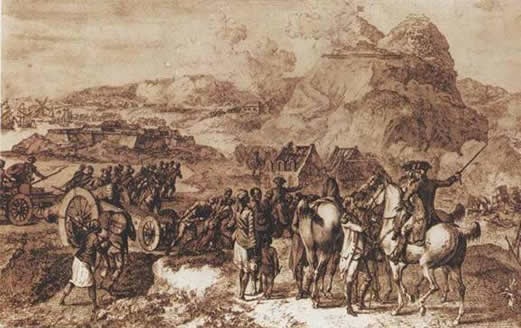Battle of Pensacola
With the Spanish declaration of war in June 1779, the Spanish and Latinx began their lengthy military campaign against the British across the entire southern flank, from San Carlos, Nicaragua to Pensacola, Florida. The British, who had hoped to divide the northern and southern states, were now forced to divert resources from their campaign against the North American rebels.
The Spanish were settled in Florida for over a century when their territory was taken by the British in the French and Indian War in 1762. The southern campaign to retake Pensacola was coordinated through Havana, and required significant supplies, naval reinforcements, and soldiers from Cuba, Mexico, Spain, Puerto Rico, and Santo Domingo to face the larger forces of British Regulars and North American Loyalists. Bernardo de Gálvez, then Governor of New Orleans, was appointed as the key military commander. Gálvez sailed to Havana on August 2, securing 4,000 men for the campaign, including reinforcements from Mexico, Puerto Rico and Santo Domingo.
By mid-October 1780, the Spanish had finalized preparations for the first invasion of Pensacola. A powerful fleet of eleven warships and fifty-one transport ships set sail on October 16, 1780. Two days later, the fury of a Gulf hurricane devastated the fleet at sea, scattering the ships throughout the Caribbean, the Campeche coastline, and the Mississippi River. The remainder of the squadron limped back to Havana on November 17. The damage to the fleet was an appalling setback.
The Spanish leadership persevered, and on February 28, 1781, Gálvez and a squadron of thirty-six warships and transport ships under the command of Captain José Calvo de Irizábal sailed a second time for Pensacola. The Army landed and disembarked on March 9. On March 24, the troops moved to the center of operations, joined by forces arriving from Mobile, Alabama. During the first weeks of April, extensive preparations for the siege began. Trenches, bunkers, and redoubts were dug, and a covered road constructed to shield the troops from the constant fire of British cannons, grapeshot, grenades, and howitzers. During this time, on April 12, Gálvez was wounded and the command was formally given to Colonel José de Ezpeleta.
Reports of a British squadron sighted near Cape San Antonio had reached Havana, and reinforcements were rushed to Gálvez. The reinforcement fleet carried a naval crew of 1,700 and 1,600 soldiers from the Havana garrison and the Spanish Army of Operations. The Spanish force then totaled 8,000 men.
On April 30, the full-scale attack on the extensive British fortifications at Pensacola began. A fortunate howitzer blast on May 8 hit the supply depot in Fort Crescent. Black smoke billowed into the sky as the gunpowder supply roared into a devastating explosion. The demise of this fort positioned the Spanish for their assault on two next positions, the Sombrero and Fort George, and on the battery of Barrancas Colorados. Twelve days of grueling trench warfare ensued.

The Gulf continued to send its tempestuous storms, and on May 5 and 6, a hurricane again struck at the Spanish ships. The Spanish Navy was forced to withdraw, fearing that the fierce sea would crash the wooden ships on the shore. The Army was on its own to continue the siege. The trenches were flooded and the troops were relieved with a ration of brandy from Gálvez. Ezpeleta, commanding the light infantry, led the charge to occupy the position at the now defused Fort Crescent, to hold the post for the next assault by the Army. Heavy fire continued against Ezpeleta’s position until 3:00 in the afternoon, when a white flag was hoisted by the British at Fort George. On May 10, 1781, the formal surrender was complete. Over 1,100 British prisoners were taken and another 200 were casualties.
The Spanish dealt a devastating setback to the British military plans in the south . The Spanish and Latinx routed the British in fierce fighting in Honduras, Nicaragua, and Guatemala. The victory at Pensacola was soon followed by the defeat of Cornwallis at Yorktown in October 1781. British politicians were then unwilling to continue the fight, and these key battles in the south were the last major campaigns during the American Revolutionary War.
For more on the Siege of Pensacola and its importance in the American Revolutionary War, please visit History.Net, America’s Spanish Savior: Bernardo de Gálvez.
